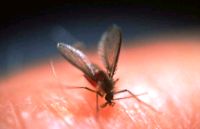 A sandfly vector of Leishmania parasites taking a blood meal through human skin.7 April is an occasion not only to mark the day on which WHO was founded but also to draw attention to specific health issues of global importance. This year WHO has chosen vector-borne diseases as a topic of focus. WHO will focus on cutaneous leishmaniasis, given the spread of this disease following the Syrian crisis.
A sandfly vector of Leishmania parasites taking a blood meal through human skin.7 April is an occasion not only to mark the day on which WHO was founded but also to draw attention to specific health issues of global importance. This year WHO has chosen vector-borne diseases as a topic of focus. WHO will focus on cutaneous leishmaniasis, given the spread of this disease following the Syrian crisis.
Cutaneous leishmaniasis is a disease that is caused by a protozoa parasite. It is transmitted to humans by the bite of infected phlebotomine sandflies. The disruption of water and sanitation systems in Syria, where cutaneous leishmaniasis is endemic in the northern part of the country, has created the perfect conditions for the phlebotomine sandfly to thrive and transfer the disease. Cutaneous leishmaniasis is a growing public health problem in the Region. It disfigures people who are infected; thus often resulting in social stigmatization and exclusion, particularly for women.
The dispersal of Syrian refugees has resulted in an increased number of cases of cutaneous leishmaniasis in neighbouring countries. Refugee camps, such as Al-Zaatari, in Jordan are reporting cases of cutaneous leishmaniasis almost on a weekly basis.
What is WHO doing to prevent cutaneous leishmaniasis?
Medicines to treat cutaneous leishmaniasis are expensive. WHO has negotiated bulk discounts with pharmaceutical manufacturers, thus ensuring that many more people have access to treatment for this disfiguring disease.
WHO and ministries of health have initiated a number of measures to prevent, detect and treatcutaneous leishmaniasis. These include water and sanitation measures including waste collection, indoor residual spraying, protection measures such as the use of impregnated bednets, and improved access to necessary health care.
WHO supports national cutaneous leishmaniasis control programmes, and is developing evidence-based policy guidelines, strategies and standards for prevention and control.
WHO promotes research on effective cutaneous leishmaniasis control, including in the areas of safe, effective and affordable medicines, diagnostic tools and vaccines.







